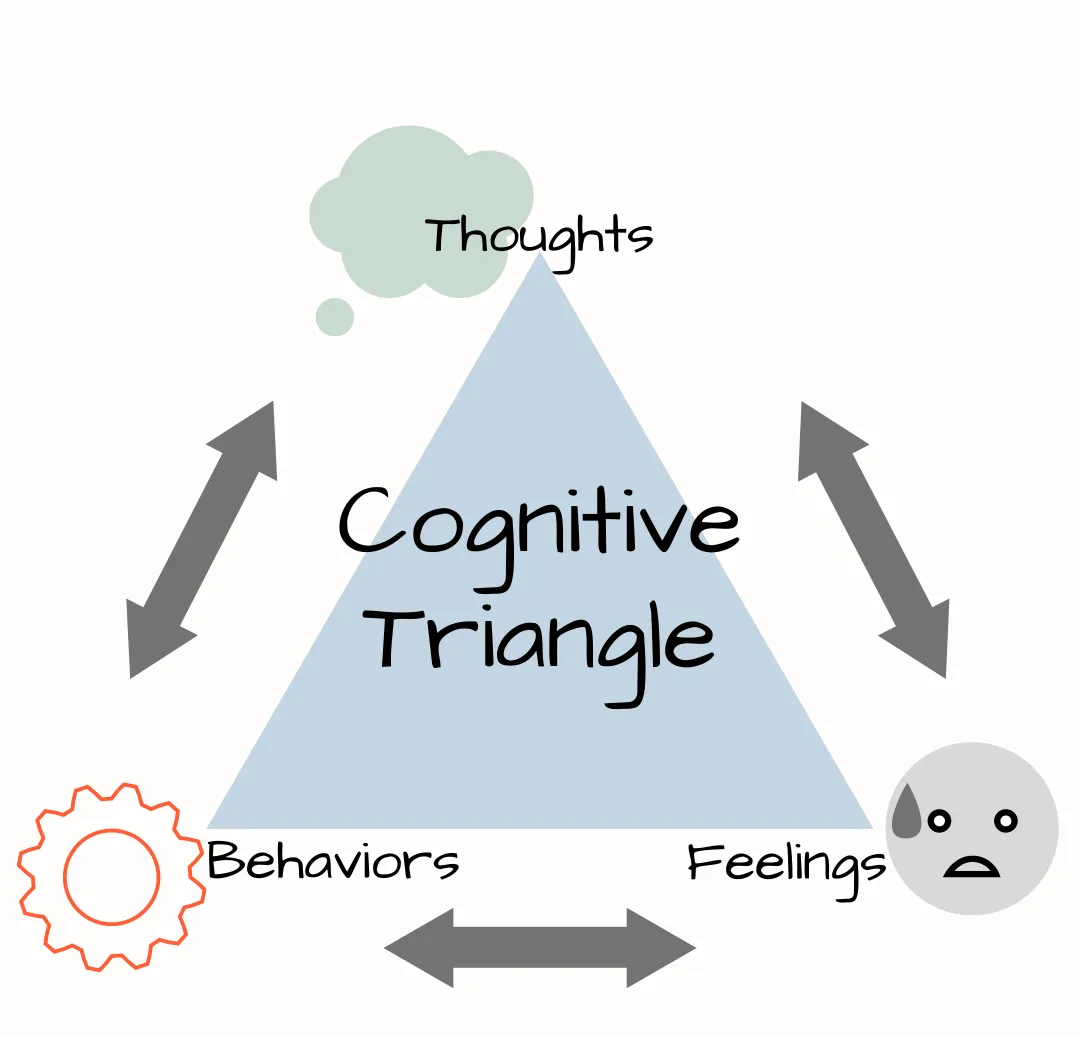Breaking the Cycle: How Thoughts, Emotions, and Behaviors Shape Each Other

By Yara Ihab - Psychologist
Modern psychology increasingly recognizes that mental well-being is a dynamic feedback system. What we think, what we feel, and what we do are not isolated experiences — they constantly interact, reinforcing either healthy or negative patterns. Cognitive Behavioral Therapy (CBT) visualizes this through the CBT triangle, where thoughts, emotions, and behaviors continuously influence one another.
Understanding this system empowers us to intervene at any point — shifting the entire cycle toward resilience.
The CBT Triangle: A Loop Shaping Everyday Life
CBT breaks down our experiences into three interconnected elements:

| Corner of the Triangle | What It Represents | Scientific Role |
|---|---|---|
| Thoughts | Internal narratives and interpretations | Influence cognitive biases & predictions |
| Emotions | Physiological and psychological responses | Signal needs, danger, pleasure, connection |
| Behaviors | Actions or avoidance patterns | Create real-world consequences that feedback into beliefs |
How the Loop Works
A negative thought → triggers distress → leads to avoidance → reinforces the original thought.
Conversely, a positive action → can reduce fear → and update the belief system with new evidence.
This is how habits, anxiety patterns, and self-image form.
Automatic Thoughts: Fast, But Not Always Accurate
Many reactions stem from automatic thoughts — quick mental judgments shaped by past experiences.
Example:
Thought: “I messed up — I’m useless.”
Emotion: Shame • anxiety
Behavior: Avoid challenges or withdraw socially
Outcome: “See? I can’t do anything right.” → belief strengthened
Our brain treats these narratives like facts, especially when guided by fear or uncertainty.
Understanding this gap between
thought vs. truth is a key therapeutic shift.
Emotional Signals: Information, Not Instructions
Instead of suppressing emotions, CBT encourages curiosity:
- What is this emotion trying to tell me?
- What triggered it?
- What do I need right now?
Emotions become data, not directives.
Anxiety may signal uncertainty — not danger.
Sadness may highlight a need for connection — not hopelessness.
Naming the feeling reduces intensity by engaging the prefrontal cortex — the brain’s logical center.
Behavior: The Most Powerful Entry Point for Change
Behavior often locks the cycle in place — especially avoidance or procrastination.
But behavior is also the easiest place to intervene.
- Small actions create new neurological evidence
- New evidence reshapes beliefs
- Emotional intensity drops
Example intervention:
If “stay home” is the anxious thought →
Take
a 5-minute walk instead →
The brain begins learning: “Nothing went wrong.”
Practical CBT Techniques You Can Start Today
There are several simple yet scientifically grounded strategies that help interrupt the negative loop between thoughts, emotions, and behaviors.
One effective approach is challenging your thoughts. This means taking a moment to examine whether a belief is entirely true or if it is being influenced by distorted interpretations. Asking questions like “What evidence supports this?” or “What alternative explanation could exist?” allows the brain to shift from emotional reasoning to objective evaluation.
Another valuable step is labeling the emotion you are experiencing. By identifying what you feel — anxiety, sadness, frustration — you activate areas of the brain responsible for regulation and decrease the emotional intensity. Simply saying to yourself, “This is anxiety, and I can sit with it,” breaks the power of the feeling to dictate your actions.
CBT also emphasizes opposite action, which means gently doing the opposite of what anxiety or fear tells you to do. For example, if a part of you wants to stay silent in a meeting to avoid embarrassment, making a short comment instead provides new evidence that speaking up is manageable. Over time, these small shifts retrain the brain toward more confident patterns.
Finally, tracking your patterns — through thought logs or mood journals — helps you detect triggers and trends you may not have been aware of. By seeing patterns on paper, you build insight and gain more control over how you respond to situations.
Together, these techniques form a powerful toolkit. When practiced consistently, even in tiny steps, they help weaken unhelpful cycles and strengthen healthier, more resilient ones.
A Forward-Looking Perspective
Future mental-health interventions — from AI-assisted therapy to digital exposure tools — increasingly rely on models like the CBT triangle because:
✔ It is measurable
✔ It adapts to data-driven personalization
✔ Small behavioral shifts scale into lasting neuroplasticity
CBT is not just a therapy —
it’s the blueprint for how the brain can change.
Final Message
Thoughts, emotions, and behaviors
shape each other constantly.
That cycle may feel like a trap — but it’s also
your way out.
Start small. Stay curious.
Notice the loop — and gently redirect it.
Change one corner → change the entire triangle.





